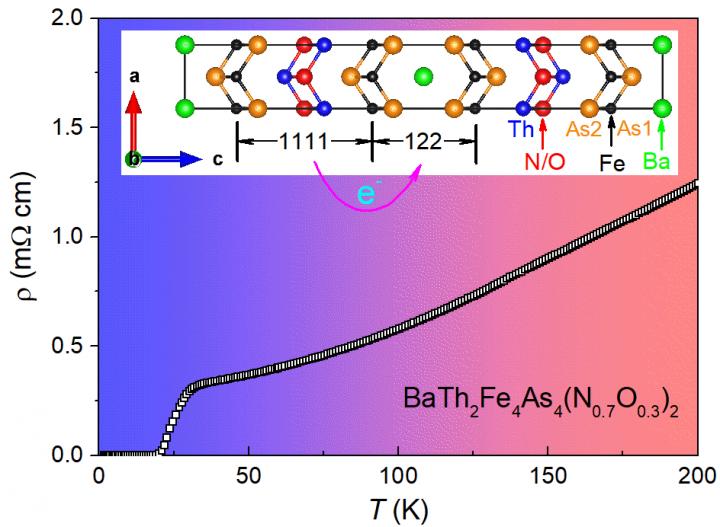A new iron-based superconductor stabilized by inter-block charger transfer

Temperature dependence of electrical resistivity for the BaTh2Fe4As4(N0.7O0.3)2 sample, indicating a superconducting transition at 30 K. The zero-resistance temperature is 22 K. The inset shows the crystal structure projected on the ac plane. The two constituent structural blocks, named "1111" and "122" respectively, are marked, and the inter-block charge transfer is shown by the arrow. Credit: ©Science China Press
The newly discovered electron-doped IBSC is BaTh2Fe4As4(N0.7O0.3)2, an intergrowth compound of un-doped BaFe2As2 and electron-doped ThFeAsN0.7O0.3 (see the inset of Figure 1). The new superconductor could be synthesized only when nitrogen is partially replaced with oxygen as in the case of BaTh2Fe4As4(N0.7O0.3)2.
Namely, the oxygen-free phase, BaTh2Fe4As4N2, could not be prepared albeit of the lattice matching. The realized synthetic process is actually a redox reaction, BaFe2As2 + 2ThFeAsN0.7O0.3 = BaTh2Fe4As4(N0.7O0.3)2, which indicates an essential role of inter-block charge transfer for stabilizing the intergrowth structure.
Note that, while both the constituent structural blocks share identical iron atoms, they contain crystallographically different arsenic atoms, as a consequence of the charge transfer.
Although the new superconductor is isostructural to the previous “12442-type” ones, it shows contrasting structural and physical properties. First, the structural details in the FeAs layers are different from those of hole-doped 12442-type IBSCs, but similar to most electron-doped IBSCs.
Second, the Hall-effect measurement shows negative Hall coefficient in the whole temperature range, and the Hall coefficient values are consistent with the electron doping level due to the oxygen substitution. Third, the superconducting properties such as the upper critical fields and specific-heat jump are close to most electron-doped IBSCs.
The onset resistive transition temperature of the new double-FeAs-layer IBSC is 30 K, and the zero-resistance temperature is 22 K. Correspondingly, the magnetic susceptibility and specific-heat data suggest two transitions, and the bulk superconductivity appears at 22 K. The result is in contrast with the single-FeAs-layer counterpart, ThFeAsN0.85O0.15, with the same doping level. The latter does not show superconductivity above1.8 K.
The essential role of inter-block charge transfer demonstrated seems to be insightful, which could be helpful for the exploration of broader layered materials beyond the layered IBSCs.
###
See the article: Ye-Ting Shao, Zhi-Cheng Wang, Bai-Zhuo Li, Si-Qi Wu, Ji-Feng Wu, Zhi Ren, Su-Wen Qiu, Can Rao, Cao Wang and Guang-Han Cao,”BaTh2Fe4As4(N0.7O0.3)2: an iron-based superconductor stabilized by inter-block-layer charge transfer,” Sci. China Mater. (2019) doi: 10.1007/s40843-019-9438-7
This article was published online (http://engine.
Media Contact
More Information:
http://dx.doi.org/10.1007/s40843-019-9438-7All latest news from the category: Materials Sciences
Materials management deals with the research, development, manufacturing and processing of raw and industrial materials. Key aspects here are biological and medical issues, which play an increasingly important role in this field.
innovations-report offers in-depth articles related to the development and application of materials and the structure and properties of new materials.
Newest articles

Superradiant atoms could push the boundaries of how precisely time can be measured
Superradiant atoms can help us measure time more precisely than ever. In a new study, researchers from the University of Copenhagen present a new method for measuring the time interval,…

Ion thermoelectric conversion devices for near room temperature
The electrode sheet of the thermoelectric device consists of ionic hydrogel, which is sandwiched between the electrodes to form, and the Prussian blue on the electrode undergoes a redox reaction…

Zap Energy achieves 37-million-degree temperatures in a compact device
New publication reports record electron temperatures for a small-scale, sheared-flow-stabilized Z-pinch fusion device. In the nine decades since humans first produced fusion reactions, only a few fusion technologies have demonstrated…





















